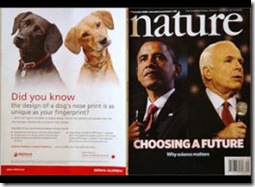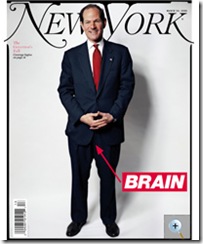1. Degrees of separation
At the New Yorker they talk about "church and state": the separation between the editorial and advertising departments. In its past life, the magazine kept those involved in the sordid task of paying for it on a separate floor of their building. Even in its current Conde Nast phase, interaction between the two areas is done with discretion and is always apparent to the reader. In an education into the inner workings of glossies I once - briefly - worked for an Australian publisher that almost required its editorial employees to ring the advertising dept to tip them off to product placement in any articles. And if there wasn't any mention of an interviewee's Louis Vuitton handbag, then why not?
 But it is unwise to stay aloof from the advertising dept, even though they - accurately - just see editorial as the stuff in between their work. Last week's pulping of the Star-Times' Sunday magazine is a case in point: "themed advertising and editorial about breast cancer awareness month" does not sit well with a cover story about that burning issue, sunbeds. The answer is a simple mock layout of the magazine's contents with pencilled-in notes of what advertising sits where, before placing the editorial in the grid. But probably go-betweens with pencils don't exist anymore. Still, the Star-Times sensibly quit while they were ahead, so they didn't feel like the publishers of Nature magazine when eating their cornflakes, and spread their mag out to use as a placemat.
But it is unwise to stay aloof from the advertising dept, even though they - accurately - just see editorial as the stuff in between their work. Last week's pulping of the Star-Times' Sunday magazine is a case in point: "themed advertising and editorial about breast cancer awareness month" does not sit well with a cover story about that burning issue, sunbeds. The answer is a simple mock layout of the magazine's contents with pencilled-in notes of what advertising sits where, before placing the editorial in the grid. But probably go-betweens with pencils don't exist anymore. Still, the Star-Times sensibly quit while they were ahead, so they didn't feel like the publishers of Nature magazine when eating their cornflakes, and spread their mag out to use as a placemat.
2. Raban parses Palin
After his excellent 1992 essay on Bill Clinton's language shifts during that election, I have been hoping that Jonathan Raban would turn his linguistic ear to the Palin phenomenon. He has just done it: in a recent London Review of Books Raban contributes "Cut, Kill, Dig, Drill". He is perfectly placed to do so, having lived in Seattle for nearly 20 years. In that time he has seen the dot-com boom come and go, and witnessed the societal shifts since 9/11, writing two excellent novels based there around those topics. He has perhaps despaired about the Bush administration as only an informed English intellectual in exile could do. From "Cut, Kill":
What is most striking about [Palin] is that she seems perfectly untroubled by either curiosity or the usual processes of thought. When answering questions, both Obama and Joe Biden have an unfortunate tendency to think on their feet and thereby tie themselves in knots: Palin never thinks. Instead, she relies on a limited stock of facts, bright generalities and pokerwork maxims, all as familiar and well-worn as old pennies. Given any question, she reaches into her bag for the readymade sentence that sounds most nearly proximate to an answer, and, rather than speaking it, recites it, in the upsy-downsy voice of a middle-schooler pronouncing the letters of a word in a spelling bee. She then fixes her lips in a terminal smile.
This was written, of course, before the vice-presidential debate, and Tina Fey's parody, which now blurs with the real thing. Negative reaction to the extraordinary governor of Alaska may be past media burnout already, and there could be a backlash at the electoral box-office, though ratings appear to solidifying in this easy-to-understand guide to the battleground states.
3. Cover lines
 There's something deeply satisfying about picking up a magazine that knows what its doing, when all the elements fall into place: the perfect mix of light and dark, the surprise extra effort that rewards readers for their loyalty. This is one reason The Word continues to give so much pleasure: there is so much thought put into it, right down to its picture captions. And its extremely funny podcasts - basically raves between veteran editors David Hepworth and Mark Ellen - are an "added value" idea that keeps people coming back. (This one, about Ellen accidentally taking Lucinda Williams out to dinner on Valentine's Night, is a classic). There's a great display of the year's best magazine covers up for an award to be decided this week. Although this example (right) perhaps doesn't have instant impact for New Zealand readers - very view of whom would recognise disgraced governor Eliot "Ness" Spitzer - the simplicity of it catches the eye immediately, and for its intended audience, it's perfect.
There's something deeply satisfying about picking up a magazine that knows what its doing, when all the elements fall into place: the perfect mix of light and dark, the surprise extra effort that rewards readers for their loyalty. This is one reason The Word continues to give so much pleasure: there is so much thought put into it, right down to its picture captions. And its extremely funny podcasts - basically raves between veteran editors David Hepworth and Mark Ellen - are an "added value" idea that keeps people coming back. (This one, about Ellen accidentally taking Lucinda Williams out to dinner on Valentine's Night, is a classic). There's a great display of the year's best magazine covers up for an award to be decided this week. Although this example (right) perhaps doesn't have instant impact for New Zealand readers - very view of whom would recognise disgraced governor Eliot "Ness" Spitzer - the simplicity of it catches the eye immediately, and for its intended audience, it's perfect.
4. Cooke's Tour
A few months ago I mentioned the impact of reading, 11 years after the event, Alistair Cooke's account of being in the room when Robert F Kennedy was shot. The Guardian has just published a selection of his classic talks: the showdown over Cuba, the revulsion over Joseph McCarthy, the cost of the Vietnam War, plus Ronald Reagan v Darth Vader (oh, and Bill and Monica, by which stage it was getting brutally obvious that it was time for the 90-year-old Cooke to close his correspondence). A friend of mine once had the job of editing Cooke for print, and it was the highlight of his week revelling in Cooke's prose to make it suit the written word, in the space available. The Guardian also offers archive audio of Cooke's deeply moving Letter From America just after JFK was assassinated, which explains the shock, and also what was lost when the New Frontier was shut down. In a succinct introduction, David Dimbleby considers the master's idiosyncratic style:
He would almost invariably open his Letter from America for the BBC with an anecdote or a description of the seasons or perhaps a reference to jazz or his favourite game, golf, "the Scottish Torture" or to the World Series. Sometimes these opening passages would last so long they reminded me of langorous days at school studying the similes in Matthew Arnold's epic poem Sohrab and Rustum and wondering, as with Arnold's long passages, where they would lead. They never disappointed, always, however circuitous the journey, finishing at some pertinent point which illustrated and so enhanced one's grasp of how the political system or culture of the United States worked.
5. On the good foot




No comments:
Post a Comment